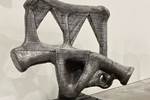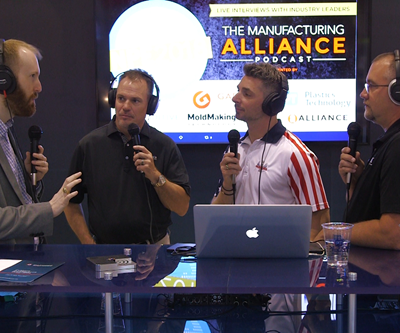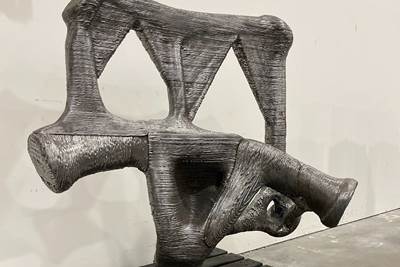This episode of the AM Radio podcast is brought to you by The Cool Parts Show.
Subscribe to the AM Radio podcast.
Somebody’s going to print the tallest or lightest part. Maybe it’s intentionally printed as such to earn the bragging rights, maybe it happens incidentally while trying to meet a customer’s needs. Either way, the superlatives are an effective way to garner attention, especially on social media. But what about the fifteenth-tallest additively manufactured part? The not-heavy, not-light, just-right parts? The parts that don’t look like an art installation, but are able to be produced at scale and meet a need? Those are the parts that Additive Manufacturing Media routinely covers and celebrates. In this episode of the AM Radio podcast, Stephanie Hendrixson and I discuss some of the best mundane parts and what makes them worth acknowledging. Listen above and follow along with the transcript below. Thanks for listening.
Transcript
Stephanie Hendrixson 00:06
Welcome to AM Radio The show where we tune into what's happening in additive manufacturing. Today our topics are going to be inspired by social media. We're talking about AM superlatives and workforce development plus introducing a new course to the show, stay tuned.
Peter Zelinski 00:28
The AM Radio podcast is brought to you by The Cool Parts Show, a video series dedicated to highlighting unique, unusual and innovative 3D printed parts watch episodes at thecoolpartsshow.com.
Stephanie Hendrixson 00:45
Hello, and welcome to the show. I'm Stephanie Hendrixson, and I'm joined today by a new voice on the podcast, Jodee McElfresh. Hi, Jodee.
Jodee McElfresh
Hi, Stephanie.
Stephanie Hendrixson
So Jodee is our digital associate editor. She's been with Additive Manufacturing Media for a while, but this is the first time you're hearing her on the podcast. But part of what Jodee does is keep an eye on what's going on in the digital world with additive. And that includes keeping up to date on what's going on on social media. So I asked her to come into the studio today to talk about some things that she's seen and kind of use that as a jumping off point to talk about issues with additive manufacturing. So that's kind of where the shape of this episode is going. But first, I want to just spend a few minutes helping our listeners get to know you, Jodee. So would you just introduce yourself and tell us like, what is your job? Exactly?
Jodee McElfresh 01:39
Oh, boy. Yeah. So I am the digital associate editor for Additive Manufacturing Media. I keep tabs on our digital publications, such as our website, our newsletters, social media accounts, I edit and publish articles, videos, this podcast. And I've been in this role since March of 2022. And fittingly, I found this job opening through social media.
Stephanie Hendrixson 02:09
That's awesome. I didn't, I actually didn't know that. So Jodee is like our social media guru. We consult her on all kinds of additive manufacturing, social media issues. If you've interacted with us, like on LinkedIn, or Twitter or Instagram, it's very likely the person you're actually dealing with is Jodee. And so like, a lot of us that work on this brand, like you didn't come from the manufacturing space, but you've been able to pick this up pretty fast. So let me just ask, what do you like about this job?
Jodee McElfresh 02:39
You know, this role is great, because it's so conducive to just ongoing learning. And ideally, most jobs entail skill expansion, learning new programs, you know, kind of developing within the role. But here, I get to learn about subject matter, that has nothing to do with digital editorship, or whatever you want to call that realm, I get to learn about manufacturing trends, different kinds of materials that are used in AM, different kinds of processes, business considerations.
Stephanie Hendrixson 03:12
What are some of the things that you find challenging about this role?
Jodee McElfresh 03:17
The downside is that when I'm editing a video or reading an article to come up with social copy, I can end up down some major rabbit holes, learning more about the topic at hand, rather than paying attention to what needs to be edited out of the podcast or, you know, photos that maybe aren't displaying correctly on our website. One of the challenges is being able to harness that curiosity. But also just dive into it because there's so much to learn, this industry is just ever evolving. So while those rabbit holes can be challenging, you know, when I'm trying to get the job done today, I just want to dive down with you and maybe see what we can find out.
Stephanie Hendrixson 04:02
Yeah, sounds good. So I asked you to kind of like bring some ideas, maybe bring even some specific social media posts today. So what's the first thing that you want to talk about?
Jodee McElfresh 04:15
The first thing I want to talk about is superlatives. One AM social media trend that I see often is superlatives. The world's biggest, smallest, heaviest, lightest, tallest 3D printed part, the world's first 3D printed X. So these are really cool things, especially for someone fairly new to this world, like me, but for someone who has been covering additive manufacturing for a few years, like you, Stephanie, I'm curious, what are the mundane things that have been most impressive to you? Like, instead of the world's tallest whatever, what is the most average size whatever that has been exciting or interesting to you?
Stephanie Hendrixson 05:01
That's a good question. And it's making me realize, like, in the time that I've been reporting on this, there used to be a time where I got a lot of story pitches that were just predicated on this is the world's first 3D printed whatever it happens to be, first 3D printed dog toy, first 3D printed, I don't know remote controlled boat, like all kinds of stuff like that, it used to be, used to feel like a little bit more significant or important. But now we're kind of past the point where it's something being 3D printed isn't necessarily like the selling point anymore, or at least we hope it's not, right? So the most average sized or mundane things that that I get excited about, at Additive Manufacturing Media, we have this inside joke that's been going on for a while that we love brackets, to the point that there is a section of our website devoted to brackets, like you'll see on some of the articles that hashtag brackets tag. We noticed that a lot of people were using 3D printing, for this really boring thing, just a bracket that's, you know, joining materials together, providing support, something like that. But it turns out that brackets are a really good use case for additive manufacturing. They are this thing that's everywhere. Its ubiquitous, like everything around you has brackets in it. And a lot of them are not really optimized, they are the shape that they are, they are the material that they are, they weigh as much as they do, because in a lot of cases, it's pretty cheap and easy to machine, a bracket out of aluminum or some other material. And so that's just how they've been made. But we're discovering through 3D printing, we have all of these different material options, we're seeing brackets that used to be metal are now polymers, or they're now composites or some other material, we have all of these different design choices. So we're able to actually optimize the bracket for the load case, or for the the product or the situation that it’s going into and so you end up with parts that that typically weigh less, they use less material, and they're like better suited to the application and the place that they're going to be installed. So brackets are a really exciting thing for us. And they're probably not ever going to be the biggest or the tallest or the smallest, or the first 3D printed object. But they're really interesting because of how sort of boring they are.
Jodee McElfresh 07:26
So when I first heard you and Pete talk about how much you love brackets, I thought, all right, you're the only two people that I think that I might ever hear, say this. But then and this is not a shameless plug, we have a video on our YouTube channel about 3D printed brackets. And there are some very passionate comments in the comment section regarding these brackets, and which is the better option. I won't get into this specific comments here. But I'll just say that comment section grows day by day by day.
Stephanie Hendrixson 08:00
Absolutely. So along with the brackets like other things that that we get excited about, we have a forthcoming episode of The Cool Parts Show that's about a clamp. So another really functional part that's being used to join things together. We've talked about air vents, we've talked about ducts, we talk about like impeller blades, stuff that in a lot of cases, you'll never see it as a consumer or as just a regular person. But it's integral to some sort of system that is making our lives possible. And so to me, like that's more exciting in a way, than we 3D printed like the tallest structure and it's just like a statue or a piece of artwork that exists somewhere that might be very beautiful to look at. But it may not actually serve any any sort of purpose. And those more mundane applications are the ones that are going to get into our cars, get into planes, get into objects that we use every day.
Jodee McElfresh 09:00
Something I'm taking away from that or something you said is these products that that aren't the one-off instances. And that's something that seems to come up a lot in our discussions here. Even in our staff meetings that you know, additive manufacturing for production. It's important, and it's what you report on in numerous articles and videos and other podcasts.
Stephanie Hendrixson 09:25
Yeah, and I think like that's sort of in the back of my mind as I'm thinking about like, what things do we get excited about? For us doing something one time like making that really cool art piece or like even something that's like representative of a rocket launcher part or something like that, but isn't isn't the real use case. It's interesting. It's impressive. I know that there are challenges associated with doing those things. But we are more interested in the manufacturer who is doing the same thing day in and day out like producing the same type of component over and over through additive manufacturing, doing it repeatedly doing it at some sort of scale. So I was flipping through some notes this week and found some from this interview that I did a while ago with a company that makes medical implants. And my contact there was talking about the challenges of taking additive into production, he said, you know, if you can make one of something that means, congratulations, you had one good day with that particular printer and that particular material and that particular design. But industries like medical, like aerospace, can't rely on you just having a good day. Like you have to formalize things, you have to standardize your process, you have to be able to do that over and over and over. So for us, like we get worked up more about a company that is printing like several thousand parts, or or maybe they're delivering a couple hundred of something month after month after month, more so than we get excited about like one single print as as beautiful or as interesting as it might be.
Jodee McElfresh 11:01
And I guess I see that at the end of the day, when there are regulated industries, like aviation and medical that it isn't about just having the biggest headline, or the most clicks on social media, even though that's what I'm looking for. It's really about finding what is just progressing our society through manufacturing.
Stephanie Hendrixson 11:26
So I guess I will say like superlatives do have a use, they’re a way to draw more attention to this technology, get people thinking about it. So I don't want to disparage them completely. But that's sort of where I'm coming from. So, Jodee, you are looking at this from a different perspective. And I'm curious, like, what do you see? Have you seen any superlatives that you think are worthwhile? Are there mundane, interesting things that you've encountered?
Jodee McElfresh 11:52
Yeah, I mean, there are definitely, there's, like I said before, the superlatives, they stand out to me, because I'm, I'm new to this, I'm still kind of, you know, bright eyed and just impressed by almost anything I see being produced. We just ran something about the giant monument that's out at the Las Vegas Raiders stadium, I thought that was really cool. And that's just because I thought it looked really cool. It's an art installation. It's a, you know, memorial, it commemorates somebody. But it was just a unique way of building that up. But I've also grown, and maybe it's because I've been spending so much time hanging around you, I've grown to appreciate the mundane of additive manufacturing. And, you know, there's one thing that has kind of lingered in my mind, it's an article that our colleague Julia Hider wrote back in the spring, and it's about this company, through 3D printing, they create parts for high fidelity aircraft trainers. So Werco Manufacturing, they build these trainers for maintenance and procedural training, and they've integrated AM in their process. And while it's a win for AM, you know, it's partially due to competition and securing the salvage parts that they need for these trainers. And there isn't the supply to keep up with the demand. In the case of some military aircraft, that competition is because some machines are staying in the air for an extra maybe decade. And when they're finally retired, the usable parts are refurbished and put back into the air. So it's a great example of circular economy and not being wasteful, which working here has also got me thinking about, but as someone who can be a nervous flyer, this is kind of scary to me. And you know, if there's any industry insiders listening who have other examples that might scare me, I don't want to know them. But anyway, this, this is another example of a seemingly mundane thing. This is essentially scrap and spare and salvage parts that impact a very important part of a very big, regulated industry. And Werco realized that through these high performance materials, I think it was PEEK and Carbon PEEK, which I can't really explain in detail here, I just don't know enough about them, materials that can be machined and powder coated, they basically created parts that can function almost identically to the true end use part for these aircraft trainers. And they're able to make machines that are pretty much good enough for an aspiring aircraft mechanic to train on. In this job, I see, I see the day-to-day manufacturing, like what people are considering what people are thinking about what businesses are considering. But then I think about me, the end user and how many things that are manufactured that I use on a day-to-day basis. And then when I think about the things that require attention to detail and that I hope are really safe like an airplane. I think it's awesome that additive manufacturing is able to meet what I think is a really important need, which is the ability to make sure someone could fix the planes that we fly on.
Stephanie Hendrixson 15:07
So yeah, like that gets back to the repeatability and the reliability of these parts. And it's more impressive, I think in those applications where 3D printing can deliver the same quality equivalent or even a direct replacement for a conventionally made part. A lot of these 3D printed objects, they are really cool and really neat. But the the really critical ones, the ones that can be made repeatedly, the ones that we can trust day in and day out, at least to me, you begin to look a lot more impressive. Alright, so let's take a break. And when we come back, we're gonna move on to a new topic, we're going to be talking about workforce development and what to do about it now rather than later.
Jodee McElfresh 15:49
Sounds good.
Related Content
Video: 5" Diameter Navy Artillery Rounds Made Through Robot Directed Energy Deposition (DED) Instead of Forging
Big Metal Additive conceives additive manufacturing production factory making hundreds of Navy projectile housings per day.
Read MoreVulcanForms Is Forging a New Model for Large-Scale Production (and It's More Than 3D Printing)
The MIT spinout leverages proprietary high-power laser powder bed fusion alongside machining in the context of digitized, cost-effective and “maniacally focused” production.
Read MoreTwo 12-Laser AM Machines at Collins Aerospace: Here Is How They Are Being Used
With this additive manufacturing capacity, one room of the Collins Iowa facility performs the work previously requiring a supply chain. Production yield will nearly double, and lead times will be more than 80% shorter.
Read MoreDMG MORI: Build Plate “Pucks” Cut Postprocessing Time by 80%
For spinal implants and other small 3D printed parts made through laser powder bed fusion, separate clampable units resting within the build plate provide for easy transfer to a CNC lathe.
Read MoreRead Next
Listen: Podcast Discusses Trends, Benefits of Metal AM for Moldmaking
An episode of the Manufacturing Alliance podcast recorded live at NPE2018 features industry experts discussing who benefits from using additive manufacturing in moldmaking and which AM trends are helping moldmakers.
Read More6 Ways Additive Manufacturing Will Change in the Next Decade: AM Radio #11B
Where will additive manufacturing go in the next 10 years? Stephanie Hendrixson and Pete Zelinski offer six ideas in the latest episode of the AM Radio podcast.
Read MoreAlquist 3D Looks Toward a Carbon-Sequestering Future with 3D Printed Infrastructure
The Colorado startup aims to reduce the carbon footprint of new buildings, homes and city infrastructure with robotic 3D printing and a specialized geopolymer material.
Read More





















